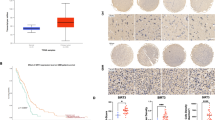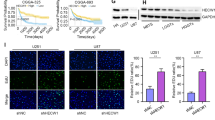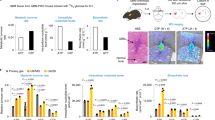Abstract
Brain tumors are associated with genetic alterations of oncogenes and tumor suppressor genes. Accumulation of reactive oxygen species (ROS) in cells leads to oxidative stress-induced damage, resulting in tumorigenesis. Here, we showed that the nuclear matrix protein nuclear restricted protein in brain (NRP/B) was colocalized and interacted with NF-E2-related factor 2 (Nrf2). During oxidative stress response, NRP/B expression and its interaction with Nrf2 were upregulated in SH-SY5Y cells. Association of NRP/B with Nrf2 was crucial for NAD(P)H:quinone oxidoreductase 1 (NQO1) expression. NRP/B was localized predominantly in the nucleus of normal brain cells, whereas in primary brain tumors NRP/B was almost exclusively contained in the cytoplasm. In addition, unlike wild-type NRP/B, the expression of NRP/B mutants isolated from primary brain tumors was found in the cytoplasm, and these mutants failed to induce Nrf2-dependent NQO1 transcription. Thus, NRP/B mutations and their altered localization resulted in changes in NRP/B function and deregulation of Nrf2-dependent NQO1 activation in brain tumors. This study provides insights into the mechanism by which the NRP/B modulates Nrf2-dependent NQO1 induction in cellular protection against ROS in brain tumors.
This is a preview of subscription content, access via your institution
Access options
Subscribe to this journal
Receive 50 print issues and online access
$259.00 per year
only $5.18 per issue
Buy this article
- Purchase on Springer Link
- Instant access to full article PDF
Prices may be subject to local taxes which are calculated during checkout






Similar content being viewed by others

Abbreviations
- ARE:
-
antioxidant response element
- GST:
-
glutathione S-transferase
- H2O2:
-
hydrogen oxygenase
- Keap1:
-
Kelch-like ECH-associated protein
- Nrf2:
-
NF-E2-related factor 2
- NRP/B:
-
nuclear restricted protein in brain
- NQO1:
-
NAD(P)H:quinine oxidoreductase 1 (nicotinamide quinine oxidoreductase)
References
Alberti I, Barboro P, Barbesino M, Sanna P, Pisciotta L, Parodi S et al. (2000). Changes in the expression of cytokeratins and nuclear matrix proteins are correlated with the level of differentiation in human prostate cancer. J Cell Biochem 79: 471–485.
Andreassi MG . (2003). Coronary atherosclerosis and somatic mutations: an overview of the contributive factors for oxidative DNA damage [review]. Mutat Res 543: 67–86.
Asher G, Lotem J, Cohen B, Sachs L, Shaul Y . (2001). Regulation of p53 stability and p53-dependent apoptosis by NADH quinone oxidoreductase 1. Proc Natl Acad Sci USA 98: 1188–1193.
Asher G, Lotem J, Kama R, Sachs L, Shaul Y . (2002). NQO1 stabilizes p53 through a distinct pathway. Proc Natl Acad Sci USA 99: 3099–3104.
Bardwell VJ, Treisman R . (1994). The POZ domain: a conserved protein–protein interaction motif. Genes Dev 8: 1664–1677.
Begleiter A, Leith MK, Curphey TJ, Doherty GP . (1997). Induction of DT-diaphorase in cancer chemoprevention and chemotherapy. Oncol Res 9: 371–382.
Berezney R, Mortillaro MJ, Ma H, Wei X, Samarabandu J . (1995). The nuclear matrix: a structural milieu for genomic function. Int Rev Cytol 162A: 1–65.
Bode J, Benham C, Ernst E, Knopp A, Marschalek R, Strick R et al. (2000). Fatal connections: when DNA ends meet on the nuclear matrix [review]. J Cell Biochem Suppl 35: 3–22.
Dalton TP, Shertzer HG, Puga A . (1999). Regulation of gene expression by reactive oxygen [review]. Annu Rev Pharmacol Toxicol 39: 67–101.
Fey EG, Penman SM . (1984). Tumor promoters induce a specific morphological signature in the nuclear matrix-intermediate filament scaffold of Madin–Darby canine kidney (MDCK) cell colonies. Proc Natl Acad Sci USA 81: 4409–4413.
Fujita M, Furukawa Y, Tsunoda T, Tanaka T, Ogawa M, Nakamura Y . (2001). Up-regulation of the ectodermal-neural cortex 1 (ENC1) gene, a downstream target of the beta-catenin/T-cell factor complex, in colorectal carcinomas. Cancer Res 61: 7722–7726.
Furukawa M, Xiong Y . (2005). BTB protein Keap1 targets antioxidant transcription factor Nrf2 for ubiquitination by the Cullin 3-Roc1 ligase. Mol Cell Biol 25: 162–171.
Getzenberg RH, Konety BR, Oeler TA, Quigley MM, Hakam A, Becich MJ et al. (1996). Bladder cancer-associated nuclear matrix proteins. Cancer Res 56: 1690–1694.
Hammarsund M, Lerner M, Zhu C, Merup M, Jansson M, Gahrton G et al. (2004). Disruption of a novel ectodermal neural cortex 1 antisense gene, ENC-1AS and identification of ENC-1 overexpression in hairy cell leukemia. Hum Mol Gene 13: 2925–2936.
He D, Zeng C, Brinkley BR . (1995). Nuclear matrix proteins as structural and functional components of the mitotic apparatus. Int Rev Cytol 162B: 1–74.
Hernandez MC, Andres-Barquin PJ, Holt I, Israel MA . (1998). Cloning of human ENC-1 and evaluation of its expression and regulation in nervous system tumors. Exp Cell Res 242: 470–477.
Hernandez MC, Andres-Barquin PJ, Martinez S, Bulfone A, Rubenstein JL, Israel MA . (1997). ENC-1: a novel mammalian kelch-related gene specifically expressed in the nervous system encodes an actin-binding protein. J Neurosci 17: 3038–3051.
Itoh K, Wakabayashi N, Katoh Y, Ishii T, Igarashi K, Engel JD et al. (1999). Keap1 represses nuclear activation of antioxidant responsive elements by Nrf2 through binding to the amino-terminal Neh2 domain. Genes Dev 13: 76–86.
Kim TA, Lim J, Ota S, Raja S, Rogers R, Rivnay B et al. (1998). NRP/B, a novel nuclear matrix protein, associates with p110(RB) and is involved in neuronal differentiation. J Cell Biol 141: 553–566.
Kim TA, Ota S, Jiang S, Pasztor LM, White RA, Avraham S . (2000). Genomic organization, chromosomal localization and regulation of expression of the neuronal nuclear matrix protein NRP/B in human brain tumors. Gene 255: 105–116.
Konety BR, Getzenberg RH . (1999). Nuclear structural proteins as biomarkers of cancer [review]. J Cell Biochem 32–33: 183–191.
Lee JM, Johnson JA . (2005). An important role of Nrf2-ARE pathway in the cellular defense mechanism. J Biochem Mol Biol 37: 139–143.
Liang XQ, Avraham HK, Jiang S, Avraham S . (2004). Genetic alterations of the NRP/B gene are associated with human brain tumors. Oncogene 23: 5890–5900.
Loidl P, Eberharter A . (1995). Nuclear matrix and the cell cycle. Int Rev Cytol 162B: 377–403.
Long DJ, Gaikwad A, Multani A, Pathak S, Montgomery CA, Gonzalez FJ et al. (2002). Disruption of the NAD(P)H:quinone oxidoreductase 1 (NQO1) gene in mice causes myelogenous hyperplasia. Cancer Res 62: 3030–3036.
Louis DN, Pomeroy SL, Cairncross JG . (2002). Focus on central nervous system neoplasia [review]. Cancer Cell 1: 125–128.
Maher EA, Furnari FB, Bachoo RM, Rowitch DH, Louis DN, Cavenee WK et al. (2001). Malignant glioma: genetics and biology of a grave matter [review]. Genes Dev 15: 1311–1333.
Nguyen T, Sherratt PJ, Huang HC, Yang CS, Pickett CB . (2003). Increased protein stability as a mechanism that enhances Nrf2-mediated transcriptional activation of the antioxidant response element. Degradation of Nrf2 by the 26S proteasome. J Biol Chem 278: 4536–4541.
Nioi P, Hayes JD . (2004). Contribution of NAD(P)H:quinone oxidoreductase 1 to protection against carcinogenesis, and regulation of its gene by the Nrf2 basic-region leucine zipper and the arylhydrocarbon receptor basic helix-loop-helix transcription factors [review]. Mutat Res 555: 149–171.
Riley RJ, Workman P . (1992). DT-diaphorase and cancer chemotherapy [review]. Biochem Pharmacol 43: 1657–1669.
Saunders WS, Shuster M, Huang X, Gharaibeh B, Enyenihi AH, Petersen I et al. (2000). Chromosomal instability and cytoskeletal defects in oral cancer cells. Proc Natl Acad Sci USA 97: 303–308.
Seng S, Avraham HK, Jiang S, Yang S, Sekine M, Kimelman N et al. (2007). The nuclear matrix protein, NRP/B, enhances Nrf2-mediated oxidative stress responses in breast cancer cells. Cancer Res 67: 8596–8604.
Venugopal R, Jaiswal AK . (1996). Nrf1 and Nrf2 positively and c-Fos and Fra1 negatively regulate the human antioxidant response element-mediated expression of NAD(P)H:quinone oxidoreductase1 gene. Proc Natl Acad Sci USA 93: 14960–14965.
Wakabayashi N, Dinkova-Kostova AT, Holtzclaw WD, Kang MI, Kobayashi A, Yamamoto M et al. (2004). Protection against electrophile and oxidant stress by induction of the phase 2 response: fate of cysteines of the Keap1 sensor modified by inducers. Proc Natl Acad Sci USA 101: 2040–2045.
Wasserman WW, Fahl WE . (1997). Functional antioxidant responsive elements. Proc Natl Acad Sci USA 94: 5361–5366.
Wechsler-Reya R, Scott MP . (2001). The developmental biology of brain tumors [review]. Annu Rev Neurosci 24: 385–428.
Zipper LM, Mulcahy RT . (2002). The Keap1 BTB/POZ dimerization function is required to sequester Nrf2 in cytoplasm. J Biol Chem 277: 36544–36552.
Acknowledgements
We thank Janet Delahanty and Makara Men for editing the paper. This study was supported by NIH grants HL80699 (SA), CA096805 (HKA) and the Department of Defense Cancer Concept Award (SA).
Author information
Authors and Affiliations
Corresponding author
Rights and permissions
About this article
Cite this article
Seng, S., Avraham, H., Birrane, G. et al. NRP/B mutations impair Nrf2-dependent NQO1 induction in human primary brain tumors. Oncogene 28, 378–389 (2009). https://doi.org/10.1038/onc.2008.396
Received:
Revised:
Accepted:
Published:
Issue Date:
DOI: https://doi.org/10.1038/onc.2008.396
Keywords
This article is cited by
-
The Role of NRF2/KEAP1 Pathway in Glioblastoma: Pharmacological Implications
Medical Oncology (2022)
-
NRF2 regulates serine biosynthesis in non–small cell lung cancer
Nature Genetics (2015)
-
Nrf2: bane or blessing in cancer?
Journal of Cancer Research and Clinical Oncology (2014)


